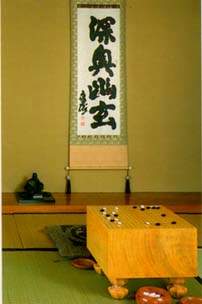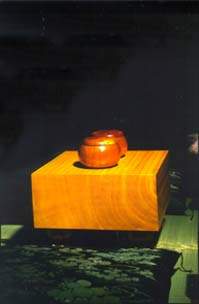
Photo shows an 8-inch thick tenmasa kaya board. The scroll in the background features calligraphy by the Nobel Prize-winning writer Kawabata Yasunari. The characters read Shin'o Yugen, which mean `subtle and profound mysteries'. It is a term often used to refer to the fascination of go.
Kaya trees are found all over Japan. However, it is the trees found in Miyazaki prefecture, Japan, which are the most highly prized, in particular, the trees harvested from Mount Aya in Hyuga. Because of the warm Japan Current, which runs past Miyazaki, boards cut from these trees have a closer grain and a more pleasing color.
Katsura is the most widely used wood for boards in Japan (both for
traditional boards with legs and for folding boards). In the past, it has been
more abundantly available than kaya, and it is hard and durable. However, traditional
katsura boards are always made with an itame grain and they lack the color
and brightness of kaya boards. Moreover, because of the hardness of this wood,
if one wishes to use expensive shell and slate stones with these boards, it
is advisable not to strike the board too strongly with them as the stones
could chip. The cheaper jitsuyo-grade stones are more appropriate to use with
these boards. The yuki-grade stones are the appropriate ones to use with kaya boards.
Caution
Another wood that is being used for go boards is spruce. It is marketed as shin-kaya, but it is a very inferior wood to be used for go boards. It is a soft wood and, after a short time, small dents will be made by stones striking the surface. The boards initially look very nice and the grain is almost always masame or tenchimasa, but the wood deteriorates rather quickly.
Since katsura trees have been overharvested in Japan, Agathis wood has recently been used as
a substitute. However, this wood is much harder than katsura, so it is advisable to
use only glass stones with these boards.

An exquisite 8-inch tenmasa kaya board, one of the finest in existence. Also shown is a set of Mikura Island mulberry bowls.
